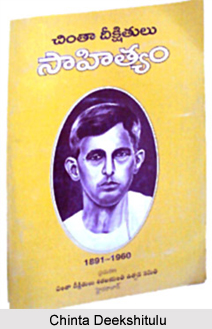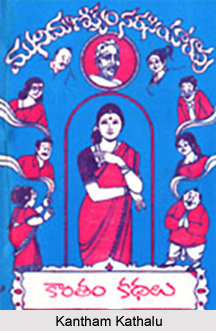 Short Story in twentieth century Telugu Literature was a rather popular prose form. Prose was greatly facilitated by the various periodical publications during this time which helped to propound this literary form. Of the many periodicals that gave encouragement and support to the short story, special mention must be made of Bharathi (1924) for the service it rendered to this genre. Besides, Sahiti Samithi, a literary organization founded by Tallavajjhala Sivasankara Sastry, also encouraged the writing of short stories.
Short Story in twentieth century Telugu Literature was a rather popular prose form. Prose was greatly facilitated by the various periodical publications during this time which helped to propound this literary form. Of the many periodicals that gave encouragement and support to the short story, special mention must be made of Bharathi (1924) for the service it rendered to this genre. Besides, Sahiti Samithi, a literary organization founded by Tallavajjhala Sivasankara Sastry, also encouraged the writing of short stories.
Short Story in Early Twentieth Century
Gurazada Venkata Appa Rao`s "Diddubaatu," published in 1910, is regarded as the first short story in Telugu literature. He published a slim volume of stories entitled Animutyalu, addressing different social problems. The potential of the short story form to address various issues without the constraints of the verse form or the diffusion of the novel form attracted a number of able practitioners. Among the pioneers of the Telugu short story, Chinta Deekshitulu, Veluri Sivarama Sastry, Viswanatha, Munimanikyam Narsimha Rao, and Gudipati Venkata Chalann figure prominently. Veluri wrote interesting stories about the social life of the middle class. His well-known story "Depression Chembu" ridicules the vanities of educated youth. Chinta Deekshitulu`s stories, written in a humorous vein, expose the absurdities of opposition to change and orthodoxy. Chalann addresses women`s issues, and his "Hampikanyalu" is considered an important work. Munimanikyam recreates the rhythms of middle-class domestic life in "Kantham Kathalu." Stories of these writers are anthologized as Tolinati Telugu Kathalu (1936-45) by the Andhra Pradesh Sahitya Akademi. Adavi Bapiraju, Karuna Kumara, Tripuraneni Gopichand, and Kodavatiganti Kutumba Rao also figure among the pioneers whose work was reviewed and assessed through Aksharabhishekam by Gorrepati Venkata Subbaiah in 1952. Many of these writers continued to write well into the decades that followed.
 Short Story in the Post-Independent period
Short Story in the Post-Independent period
Technical sophistication, the use of spoken language, and international recognition mark this phase. A fairly representative selection of stories from 1946 to 1955 published by the Andhra Pradesh Sahitya Akademi under the title Oka Dasabdi Telugu Kathalu (1980) testifies to this fact. These stories demonstrate an ability to combine formal, technical accomplishment with social awareness and responsiveness; the skill and sensitivity that went into the work, proclaim the maturity of the genre. Palagummi Padmaraju`s Galivana won second prize in an international competition held by the New York Herald Tribune in 1952. Puranam Subrahmanya Sarma`s "Neeli" won first prize in the Telugu section of the 1953 version of this competition. Such achievements indicate that the gains of the early period had now been consolidated.
The chief feature of this period is the wide thematic variety. The lives of the socially deprived classes are mirrored in Puranam`s "Neeli" and Karuna Kumar`s "Rickshaw Wallah." Jamadagni`s "Marupurani aa Vooru," Kavikondala Venkat Rao`s "Zamindaru," and Veluri`s "Arachakam" depict the life and landscape of the various regions of Andhra Pradesh and reflect village politics while re-creating rural life.
The complex inner life of an average person is powerfully portrayed in the psychological stories that probe the depths of human thought, emotion, and experience. Palagummi`s "Galivana," Hitasri`s "Nijanijalu," and Amarendra`s "Panjaram" belong to this category. Women`s issues figure prominently in Balivada Kantha Rao`s "Paadulokam, Paaduman-ushulu," Gopichand`s "Karyasurudu," and Buchibabu`s "Thananu Gurinchina Nijam." Such stories reflect the changing relationship between man and woman and debate the validity of marriage as an institution. The common person`s dream of a classless society and the struggle of an budding new society with the forces of inaction and corruption find expression in stories such as Kalipatnam Rama Rao`s "Palayithudu," Ravisastri`s "Puvvulu," and Munipalle Raju`s "Bicchagalla Jenda."
Even as the established writers of the 1940s and 1950s continued to be prominent, other writers entered the field, adding variety and experiment to it. R. Vasundhara Devi, Seela Veerraju and Saurees exploit a wide range of narrative possibilities in their stories. In general, the newer writers continued to build on the foundations provided by the established writers. The thread of continuity, however, also gives some glimpses into certain common weaknesses of the Telugu short story: a tendency to make explicit end statements, prolongation of the narration beyond a good technical ending, and a weakness for purple prose. Such weaknesses mar the impact of many a good story. Yet, to read Ravuri Bharadwaja`s "Paristhitula Varasulu," Ravi Sastri`s "Lakshmi," or R. S. Sudarsanam`s "Madhura Meenakshi" is to become aware of superb craftsmanship, excellent plotline, fine sense of ending, engagement with contemporary society, and aesthetic refinement. Such stories affirm that the Telugu short story is equal to the best practice anywhere in the world.



















